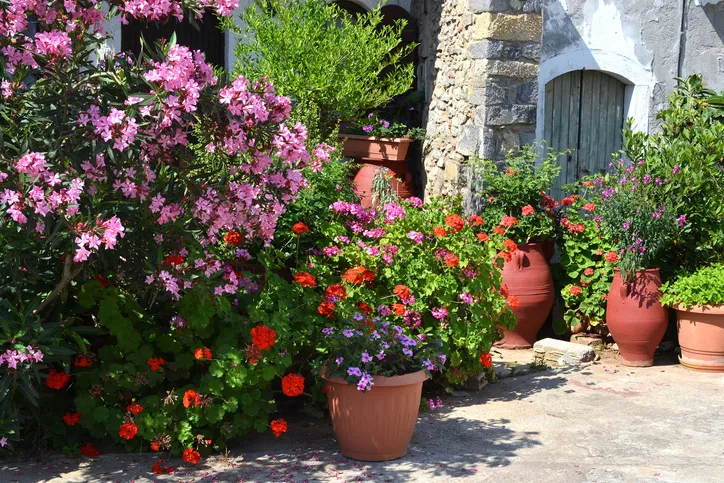- Which location do oleanders prefer?
- Can I also plant oleanders in the garden?
- What substrate does oleander need?
- How Often Should I Water an Oleander?
- When and with what to fertilize an oleander
- How much can you cut an oleander?
- My oleander is getting yellow leaves. What is the reason?
- The leaves on my oleander are turning brown. Why?
- Which pests are particularly common in oleanders?
- Which diseases can still occur in oleanders?
- How to propagate oleander yourself?
- How should oleanders be overwintered?
The oleander (Nerium oleander), also known as rose laurel, originally comes from the Mediterranean region, but is also widespread in the Near and Middle East as well as in China and India. The evergreen, very richly flowering and woody shrub can grow up to three meters high. In Germany, the plant, which comes from the dogbane family, is not hardy and can therefore only be cultivated in large containers. In the following care instructions, we will show you how to get your oleander to flower for a long time.
 The oleander is used to the Mediterranean climate
The oleander is used to the Mediterranean climate
Which location do oleanders prefer?
The plant, which is used to a Mediterranean climate, prefers a full sun and warm location that is as free from drafts as possible. Varieties with double flowers in particular should be protected from rain (e.g. by storing the plants under an eaves in case of a fall), otherwise fungal diseases can develop very easily.
Can I also plant oleanders in the garden?
Oleander is only hardy to a maximum of minus five degrees Celsius and should therefore only be planted in mild regions and with sufficient protection in the garden. However, the wood can be cultivated very well in large tubs.
What substrate does oleander need?
The plant has a very high nutrient requirement and therefore needs a nutrient-rich, permeable substrate such as potting or garden soil, which you can also enhance with humus soil. Young oleanders should be repotted once a year, older specimens at least every five years, with a complete replacement of the substrate.
How Often Should I Water an Oleander?
Especially during the main growth period in the hot summer months, you should water oleanders twice a day - in the morning and in the evening. It doesn't do any harm if you leave excess water in the trivet, because the plant has an immensely high water requirement and will also use up this water quickly. If it's not that hot, the plant doesn't need quite as much water, of course. Oleander must not dry out, but it should also not be permanently wet. In winter, on the other hand, you need to water only rarely and little.
When and with what to fertilize an oleander
Due to the high nutrient requirements, oleanders should be supplied with a good flowering plant fertilizer once or twice a week during the growing season.
How much can you cut an oleander?
Basically, oleander does not have to be cut back, because the shrub also branches very well on its own. If the plant gets too big, you should wait until after the first flowering before pruning - oleanders pruned in autumn or spring will no longer produce flowers in this or the following season. However, you can carefully pluck faded flowers to stimulate the development of flowers.
My oleander is getting yellow leaves. What is the reason?
Lightened to yellow leaves in oleanders often indicate a lack of nutrients, for example due to a lack of fertilization. However, the substrate can also be unsuitable or have an incorrect pH value. Repot the affected plant in fresh substrate, add some garden lime (9.70€) if necessary and/or preferably water with calcareous water. However, if the yellow leaves do not appear in large numbers, but only sporadically, an otherwise healthy oleander will only shed old leaves.
The leaves on my oleander are turning brown. Why?
Brown spots on the leaves or brown leaf edges are often the result of sunburn, which occurs after clearing out the winter quarters as a result of insufficient getting used to the sun. Oleander should be slowly and gradually reaccustomed to a spot in full sun, but should not be placed in full sun immediately.
Which pests are particularly common in oleanders?
Spider mites, thrips and scale insects in particular often visit the bush with the leathery leaves. With these pests, however, you do not need to resort to lethal injections right away, because biological (and self-made) antidotes often work very well.
Which diseases can still occur in oleanders?
In particular, oleanders that are not sufficiently fertilized and are therefore weakened often suffer from oleander canker, which is caused by the bacterium Pseudomonas and is primarily shown by brownish growths on the shoots. The only remedy against this disease is a vigorous pruning into the healthy wood.
How to propagate oleander yourself?
Oleander cuttings can be rooted in a glass of water and, as soon as the roots are strong enough, planted in a pot with soil. If possible, cut the corresponding shoots in spring or early summer. It can also be propagated using self-collected or purchased seeds.
How should oleanders be overwintered?
Oleander should overwinter in a bright and frost-free winter quarters at about five degrees Celsius.
tips
As beautiful as the flowering shrub looks, all parts of the oleander are highly poisonous! So better keep children and pets away from the plant.